If you already own a 3d printer, you are surely aware of PLA and even ABS. Perhaps, you already tried printing other less popular filaments, like PETG, TPU, and ASA, among others. Before you buy a spool of these, you may find it usefull to know if your 3d printer is compatible with that specific thermoplastic.
In short, what types of filaments can you print with a regular 3d printer?
Both Bowden-Type and Direct Drive 3d printers are able to print ABS, PLA, PETG, ASA, TPU, and PTE, although Bowden printers generally have a tougher time printing with flexible filaments because they can’t as easily be pushed through the Bowden Tube. It is also usually recommended to use more resistant nozzles to print with abrasive filaments
- Filaments most consumer-grade printers can print
- Filaments you can use with Bowden and Direct Drive extruders
- Filaments you can print without an enclosure
- Filaments that require higher extrusion temperatures
- Filaments you can use with the most common nozzle types
- Check out our recommended products section
Filaments most consumer-grade printers can print
The kind of filament that you’ll be able to use for your printings will highly depend on your extruder type, nozzle material and if you are using an enclosure or not. Nonetheless, there is a broad spectrum of popular thermoplastics that almost any printer setup will be able to successfully print
These would essentially be PLA and ABS, PETG, for printers such as the Ender 3 and other similar desktop 3d printers. Other materials such as Nylon, Polycarbonate, and even TPU are definitely printable on these types of machines but generally require some modifications like changing from Bowden to Direct Drive extruders, replacing the hot end for one that can achieve higher temperatures, getting a more durable nozzle, and using an enclosure for the printer.
You should always take into consideration the temperature at which your filament melts. Most PTFE tubes that come with the printers that use a Bowden setup can’t sustain high temperatures for prolonged periods and can turn black and get ruined, so if you are going to be printing over 240°C in most cases you will need to replace the factory PTFE tube with a higher quality one for high temperatures. That won’t be a concern if you are using a Direct Drive setup.
Here’s a quick list of the filament brands I’d recommend:
Filaments you can use with Bowden and Direct Drive extruders
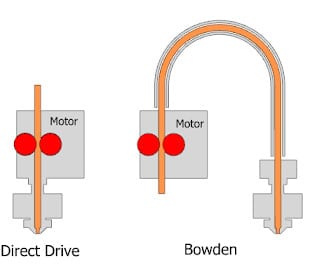
If you own a Fused Deposition Modeling (FDM) printer, you either have a Bowden or Direct Drive extruder setup. In a Bowden system, the drive gears and the hot end are separated. The drive gears are usually mounted on the printer’s frame and push the filament through a PTFE tube into the hot end.
On the other hand, a Direct Drive system has the drive gears mounted on top of the hotend and from there it pushes the filament directly into the nozzle. They both accomplish the same function but every system has its own advantages and disadvantages.
Bowden systems usually require more acceleration and retraction to compensate for the friction in the PTFE tube but since the drive gears and the hot end are separated there is much less weight on the nozzle resulting in faster and more precise prints. The downside of a Bowden system is that it is more limited when it comes down to the different types of filament you can use since abrasive and flexible filaments can stick and damage the PTFE tube.
Direct Drive setups have heavier printheads since the drive gears are mounted over the hot end thus causing more wobble and sometimes inaccuracy in movements. On the other hand, Direct Drive extruders have fewer extrusion or retraction-related issues and can use a wider range of filaments.
In a nutshell, and although it is possible to obtain good results, Bowden-type printers are not suitable for printing flexible or abrasive filaments. The most popular flexible in the 3d printing space is currently Thermoplastic polyurethane, better known as TPU. By “abrasive filaments” I mean thermoplastics that have some percentage of other materials, such as wood or some type of metal.
It’s worth noting, however, that not all TPU is created equal and there are some harder TPU’s that you can print with a Bowden extruder, but you will have a hard time printing something like NinjaFlex since it’s almost like a rubber band, and try pushing that through the tube.
I have an entire guide on how to print TPU with an Ender 3 (Bowden-type printer) that you should absolutely check out.
Filaments you can print without an enclosure
Most consumer-grade 3D printers are designed and shipped without an enclosure as it reduces the costs, weight, and size of the machine. An enclosure protects your prints from drafts and temperature changes as well as keeping the dust away and containing the fumes emitted by some of the filaments when printing. The stable temperature inside the enclosure is very helpful to print with some filaments but it isn’t a requirement for many of them.
You can perfectly print PLA, PETG, TPE, and TPU without an enclosure. On the other hand, filaments like ASA and ABS are recommended to be printed with an enclosure, but you can still print small models with those filaments. Larger models printed with ASA or ABS will most likely warp without an enclosure.
If you’re looking for an affordable and non-flammable enclosure, then I’d recommend trying this one by Creality.
Filaments that require higher extrusion temperatures
Different printers have different maximum printing temperatures and mainly determine how hot the hotend can get. This which will determine the array of filaments that a given 3d printer print (as will the nozzle, and if it’s Direct Drive or Bowden). The higher temperatures a hot end can achieve, the more filament types you will be able to print with.
Although the manufacturer specifications often state high temperatures, such as 280°C for the Ender 3, there are other limiting factor that will limit the range. For example, if you use a Bowden-Type printer, printing at temperatures over 240°C or 250°C should be avoided if you are using a low-quality PTFE tube.
If you are willing to replace your hot end with one that can get higher temperatures, you will most likely need to also adjust the restrictions on your printer’s firmware to be able to raise the max temperature safety feature. Also, some hot ends distance the PTFE tube from the heat block with a heatbreak so you don’t have to worry about the PTFE tube getting damaged.
Most hobbyist 3d printers, even the ones that are in the “prosumer” category, are not able to achieve the required temperature for printing PC-ABS, Polycarbonate, and other popular thermoplastics used by industrial-grade 3d printers.
Filaments you can use with the most common nozzle types
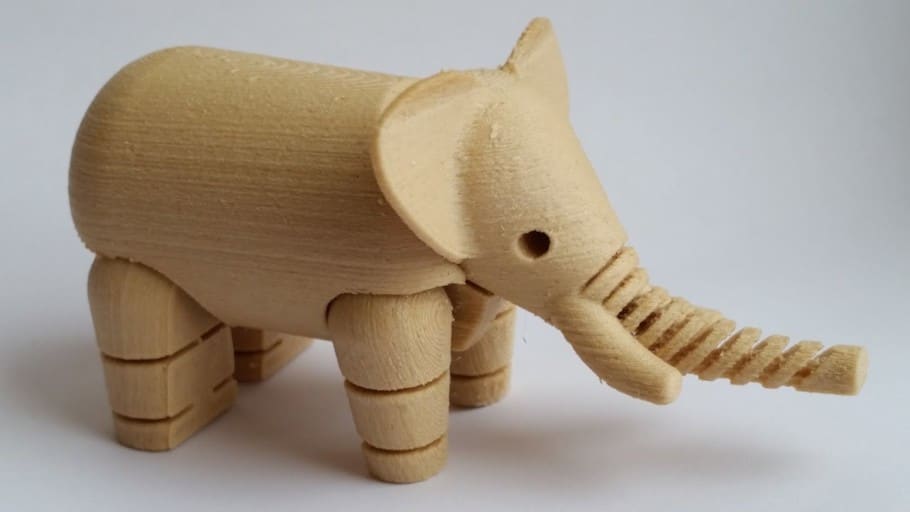
If you’ve never heard about different nozzle types, you probably have a brass nozzle installed on your 3d printer. You may be interested in knowing that nozzles are also made from stainless steel, hardened sttel and even ruby. Each nozzle type serve a different purpose, and obviously comes at a different price tag.
Different nozzle types are also better suited for printing with different filaments, so I find it important to briefly go through each one of them.
Brass Nozzle
Brass nozzles are the most commonly used nozzles. Brass is a great heat conductor so the temperature of the nozzle will be much closer to the temperature of the heater block making it easier to print with this nozzle.
On the downside, brass is also a relatively soft metal so you should avoid any abrasive filaments as they will damage the nozzle and decrease the printing quality, even to the point where the nozzle is no longer usable.
Unless you want to print with an abrasive filament, a good quality brass nozzle is definitely the go-to choice, since they are cheaper, faster, and produce outstanding prints. I always recommend brass nozzles when printing with PLA, ABS, PETG, NYLON, and TPE.
Stainless steel nozzle
Stainless steel nozzles are more durable than brass nozzles, and can therefore be used to print with abrasive filaments (although they aren’t as good as the hardened steel ones for this purpose).
Their thermal conductivity falls short when compared to brass nozzles, which means that you will probably need to adjust your temperature settings and perform some tests until you arrive at the right parameters. Additionally, I also recommend first trying to print with lower movement speeds.
Most importantly, stainless steel nozzles have been declared food-safe by the FDA, so you can use them for projects where food will be involved. Stainless steel nozzles can be used for any filament but it is still not recommended for heavy and repeated use of abrasive filaments.
Hardened steel nozzle
Hardened steel nozzles are extremely durable and can sustain heavy printing sprints with abrasive filaments for long periods before you will need to replace them.
On the downside, these nozzles have even lower thermal conductivity than stainless steel nozzles, which means that they will take longer to achieve the desired temperature and thus you will need to adjust temperature settings. The inside of these nozzles is not as smooth as the others, resulting in a lower printing performance when compared to other nozzle types.
You should consider using hardened steel nozzles to print with abrasive filaments like NylonX, Wood-Filled, Metal-Filled, Ceramic-Filled, Wax-Filled, and glow-in-the-dark filaments.
Special mention: Olsson Ruby Nozzle
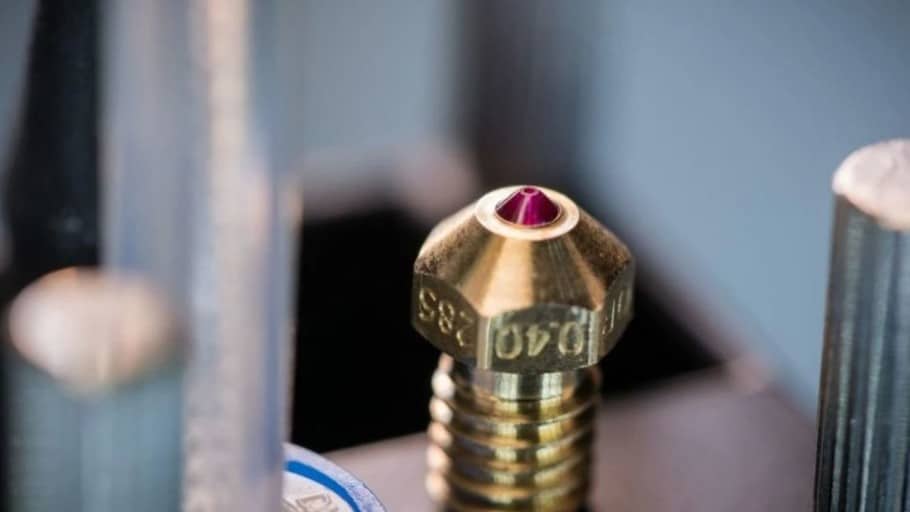
The Olsson Ruby nozzle is not a common nozzle at all. These nozzles have a brass base with a ruby in their tip. While the brass base allows for good thermal conductivity, the ruby tip is very resistant and can be used with any type of filament even the most abrasive ones.
Given that these nozzles have excellent performance and durability, they are expensive. You should only consider using them if you have very specific printing needs that require almost only abrasive filaments. If you only use abrasive filaments sporadically and mostly print with PLA or ABS, it would be extremely cost-inefficient to use a ruby nozzle.
Check out our recommended products section
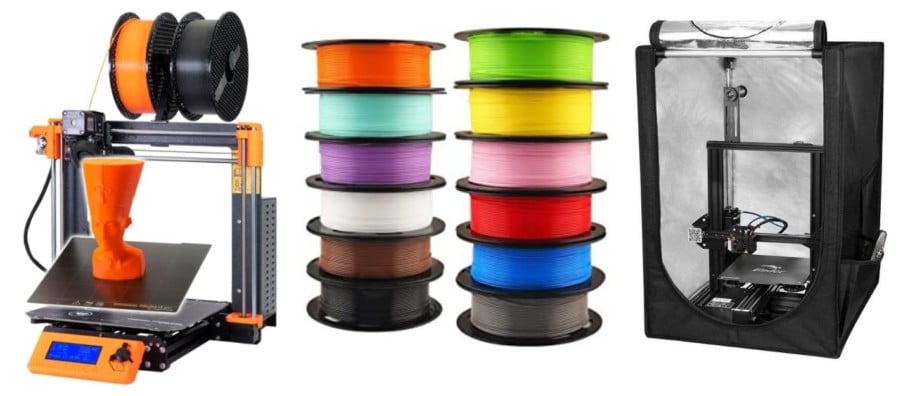
We created a recommended products section that will allow you to remove the guesswork and reduce the time spent researching what printer, filament, or upgrades to get, since we know that this can be a very daunting task and which generally leads to a lot of confusion.
We have selected just a handful of 3D printers that we consider to be good for beginners as well as intermediates, and even experts, making the decision easier, and the filaments, as well as the upgrades listed, were all tested by us and carefully selected, so you know that whichever one you choose will work as intended.
Error processing API data.
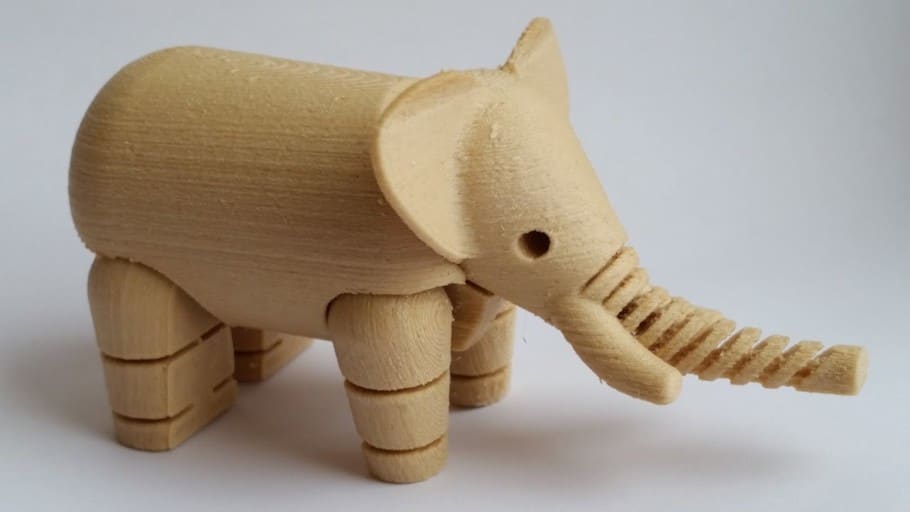
Great article, well written and easy to understand. I am looking to get my first 3d printer and this article is helping me make decisions about which criteria I want to focus on.
Thank you!